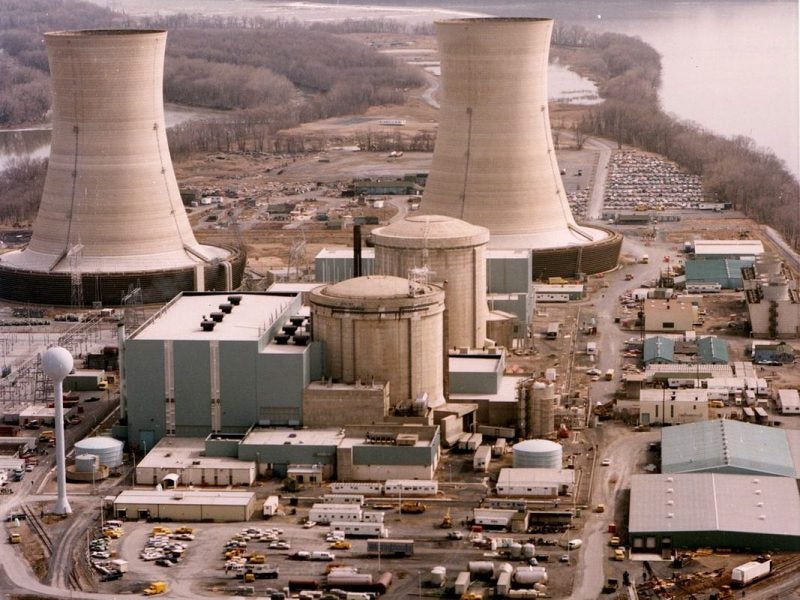
18 May 1968 – Construction begins
Building began on the first reactor at Three Mile Island (TMI-1) in May 1968. Designed and built by industrial services company Babcock & Wilcox for a then cost of $400m (now just under $3bn), TMI-1 was a pressurised water reactor (PWR) with a net capacity of 819MW. It was completed and commissioned on 2 September 1974.
Unit 2 (TMI-2) followed, with construction of the 906MW reactor beginning on 1 November 1969 and only completed on 30 December 1978. TMI-2 was delayed due to being over budget at $700m in 1978 ($2.8bn now) and legal challenges made by the Three Mile Island Alert (TMIA). Things would get worse for TMI-2 a year later.
28 March 1979 – Here comes the boom
At 4am on 28 March 1979 the newly built Unit 2 suffered a severe meltdown. It was caused by a minor malfunction of the secondary cooling unit that caused the primary coolant temperature to rise and caused the reactor to shut down automatically.
A chain reaction began, which included leaking reactor coolant, increasing the amount of steam in the primary cooling unit and replacement water getting in the reactor system.
Radioactive gases from the reactor cooling system built up in the makeup tank of the auxiliary building and leaked out of compressors, releasing the radioactive gas to the environment. However this material had a short-half life and was ‘biologically inert’ so did not pose a threat to the public.
Despite the ensuing public panic and reporting, there were no fatalities and the Pennsylvania Department of Health recorded no usual health trends in the years afterwards. The clean-up of TMI-2 cost $973m and took 12 years to complete.
1979 – 1989 Nuclear fallout
The fallout from the accident dragged on for years. America’s Nuclear Regulatory Committee (NRC) shut down TMI-1 in July 1979 until it received assurances that it would work safely.
Meanwhile, plant owners Metropolitan Edison (MetEd) blamed the accident squarely on plant designer Babcock & Wilson. MetEd sued the company for $500m in 1980 (over $1.5bn now) and also filed a lawsuit against the NRC for $4bn (nearly $12.5bn). While doing this, MetEd renamed itself as GPU Nuclear to disassociate itself from the incident.
The company also had to deal with US Department of Justice. It was indicted on 11 counts and eventually plead guilty to one and does not contest six others. GPU accepted a $45,000 fine in February 1984 (now $110,000) and settled a class action suit for $1.25m due to high utility rates in July 1988 (now $2.7m).
But, by the end of the decade TMI unit 1 was ranked the most productive nuclear power plant in the world.
1998 – 2003 – New millennium, new owners
At the close of the millennium TMI went through a change of ownership. GPU sold TMI 1 to the American Energy Company, a company jointly owned by Peco Energy (now Exelon) and British Energy for $100m (now $157m) in July 1998, with the deal being certified by the NRC in April 1999.
In the wake of the 9/11 attacks on the World Trade Centre, the plant found itself the target of a potential terrorist threat including “internal and external sabotage,” which was eventually stated as “non-credible”.
If any year symbolises TMI it was 2003. The plant broke a world record of 680 days of continuous operation and Exelon bought out British Energy’s share of the plant for $276.5m making it the sole owner of the plant, but TMI-2 was again the victim of an incident where a 55 gallon drum in the turbine caught fire within the turbine building. No radiation was released but it cost the plant $100,000 in repairs.
November 2016 – Wikileaks releases the Carter Cables
Controversial ‘transparency’ group Wikileaks released a trove of documents from the presidency of Jimmy Carter (1976-1980), especially on the TMI accident.
The documents, which were actually declassified two years before, show how the world reacted to the incident. Due to its large civilian nuclear infrastructure, France wanted to send scientists to study what happened at the site. French newspaper Le Figaro also stated that the accident had “brought to the forefront the division between proponents of the nuclear program and environmentalists.”
Meanwhile India queried whether an incident like TMI could happen in their own reactors, but stated that it believed this was unique to PWRs and the boiling water reactors that India was using would have been able to control and stop such an incident.
2011 – 2019 – The long goodbye to TMI
In the wake of the Fukushima accident, TMI was reviewed by the NRC and was found to be operating safely and at no risk, but creaks in the plant began to appear in 2012.
It was shut down for two weeks in August of that year due to problems with the heater in the plant’s pressuriser tank. A month later it had to shut down again for two days due to a malfunctioning cooling pump causing an automatic shutdown.
After further shutdowns in July 2014 and May 2015, the plant was hit with the news in August 2015 that it failed to secure a contract to sell electricity in 2018-2019.
Having failed to once again to secure a contract in May 2017, Exelon announced that the plant will close in September 2019, officially confirming the closing date in May.



